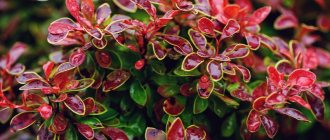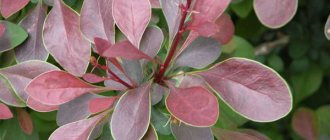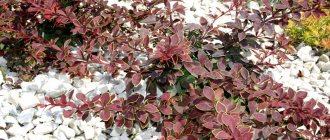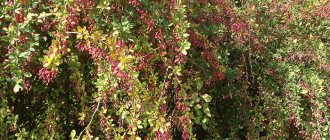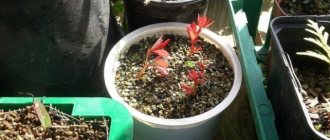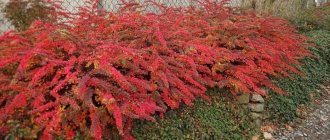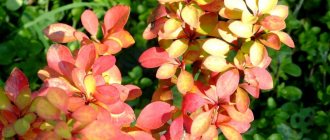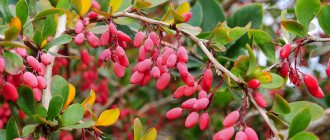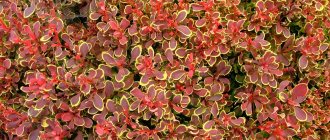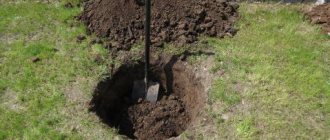To create a sophisticated and attractive landscape, plant shrub compositions are justified. The amazingly beautiful Thunberg barberry of the Atropurpurea variety changes the color of the foliage throughout the year and makes the exterior of the site original. The red-purple rounded crown with yellow flowers and oblong fruits will be a bright solitaire accent or create a spectacular hedge.
Description of barberry Atropurpurea
Barberry Atropurpurea belongs to the barberry family. This is a beautiful spreading shrub. The branches of the plant have sharp thorns - these are modified leaves. They remain purple throughout almost the entire season. The color change during the growing season is insignificant; it differs mainly in the saturation of tones. At the beginning of the season, the leaves are a bright purple tone, in the middle the tone is slightly muted, and at the end the color adds a deep, rich tone.
Barberry Thunberg Atropurpurea
The Caucasus region is considered the homeland of the bush. The plant has great endurance - it easily tolerates both heat and moderate frosts. In the Middle Zone, Atropurpurea barberry is often used by designers in garden compositions to replace heat-loving boxwood.
The plant is not picky about soil quality; it can easily tolerate rocky soils and loam. Planting on slightly acidic soils with an acidity not higher than 7.0 pH is acceptable.
The plant is used as an ornamental shrub. Despite the fact that it bears fruit abundantly, the red, slightly elongated fruits, unlike other types of barberry, are inedible - they have a bitter-sour taste.
The shrub can be classified as a weakly growing plant; only by the age of 5 it grows to a height of 2 meters. The crown reaches 3.5 meters in diameter. Barberry Atropurpurea has standard sizes - a high and spreading crown 4 meters high and 5-5.5 meters in diameter. The mini version is called Barberry Thunberg Atropurpurea nana - it is a dwarf plant up to 1-1.4 meters high and has a small crown.
Young 2-year-old barberry seedlings
The plant is very responsive to sunlight. This must be taken into account when choosing a landing site. It tolerates partial shade relatively well - the main thing is that 2/3 of the day sunlight falls on the bush. When placed in the shade, the foliage loses its decorative properties, becomes green, and growth quickly slows down.
The plant has been used in landscaping since the 1860s. Barberry ordinary Atropurpurea remains one of the most popular plants for urban gardening and landscape design today.
Features of culture
Barberry Koronita is a medium-sized ornamental shrub that has arched branches. The height of the bush does not exceed 0.5-1 m. The shape of the plant is quite spreading, cushion-shaped. The bush can reach up to 1.5 m in width
The root system is superficial, it is important to be very careful when weeding, removing weeds and loosening the root zone. During the season, the growth of the bush averages about 10 cm. In total, Coronita stands out among other varieties for its original appearance
The peculiarity of this variety is that the bright beautiful leaves sometimes change color to bright purple in autumn.
In total, Coronita stands out among other varieties with its original appearance. The peculiarity of this variety is that the bright beautiful leaves sometimes change color to bright purple in autumn.
Even the thorns of the bushes are very bright and immediately attract attention. They are quite large in size, pink in color, with a creamy tint, juicy and attractive
Barberry Thunberg Koronita
Another feature of the variety, which is successfully used by most gardeners and landscape designers, is that the plantings can be given any shape and appearance by cutting the branches. The inflorescences, located densely along the entire length of the branches, have a bright yellow color. In the harsh climatic conditions of the Russian climate, the plant adapts perfectly and grows well without much difficulty, and feels great in both hot and cool weather.
Koronita barberry blooms towards the end of spring, and in autumn the bushes are decorated with beautiful bright red fruits. But you shouldn’t eat them, as they are not only inedible, but also poisonous. When eating the fruits, serious digestive disorders and poisoning can occur. The only purpose of the fruit is to additionally decorate the bushes.
Features of use
A description of the barberry variety Koronita will not be complete without indicating the scope of use of the plant. As has already become clear, it is impossible to use the fruits as food, so the plant is used exclusively for decorative purposes. In landscape design, the use of barberry bushes is multifaceted.
Used for decorative purposes only
Many people use such plantings as hedges and borders. The bushes are easy to trim and can be changed in shape. In our country it is not possible to use boxwood shrubs for decorative purposes; barberry bushes of this variety will be an ideal alternative. They give the gardener the opportunity to realize any fantasies. Since the growth of Thunberg Coronita barberry bushes is small, the hedges will not be too high, but if trimmed correctly they will be very beautiful.
Often such bushes are used to create rock gardens and beautiful compositions in the garden.
Planting a plant
Barberry Thunberg - description of plant varieties
Planting in open ground is carried out in the form of 2-3 year old seedlings or cuttings. Planting seeds and germination in natural conditions is considered ineffective - seed germination in natural conditions is 25-30%. Therefore, it is recommended to plant seedlings in a container.
Planting from seeds
In closed ground conditions, seed cultivation is carried out in containers or in greenhouses. The barberry fruits are removed from the tree, peeled and dried for 2-3 days in sunlight. For planting, a substrate of sand, humus, or turf soil with a pH of no more than 6.5 is used. Seeds are disinfected for 4-6 hours before planting. Planting depth in the ground is 1-1.5 cm.
After emergence of seedlings, remove the film and control soil moisture. The soil in the container should not be too wet, but it should not dry out either. It is recommended to fertilize with complex fertilizers and preparations that promote the growth of the root system 21-28 days after emergence.
Planting in containers is carried out in the second half of February - early March. The hardening procedure begins when the air temperature reaches 10-12 ℃ above zero. Transfer the plant to fresh air after May 15 - when the threat of frost has completely passed. In the second half of September, it is recommended to transplant the plant into a larger container for wintering.
Barberry Atropurpurea in late autumn
Planting seedlings in open ground
For planting in open ground, 2-3 year old seedlings are used. A place with plenty of sunlight and moderate moisture content is considered optimal. An adult plant does not tolerate places with high groundwater levels, wetlands, and lowlands.
When choosing a location, take into account the fact that Atropurpurea barberry has a large spreading crown. When planting it as a separate plant, the distance to nearby plantings should be at least 3.5-4 meters.
Additional Information! Before planting, the soil is prepared. When planting in spring, holes are dug in the fall and compost, sand are added and liming is carried out. When planting in autumn, all this work is done in 2-3 weeks, so that by the time of planting the acidity of the soil is already normalized.
When planting seedlings 2-3 years old, the dimensions of the hole should be 30x30 cm and up to 40 cm deep. Dolomite flour or lime must be poured onto the bottom. The deoxidizer is sprinkled with a layer of sand on top. For backfilling, it is recommended to use peat, sand, and top fertile soil. The backfill mix is prepared in the following proportion: 2 parts compost, 2 parts humus, 3 parts fertile soil, 300-400 grams of superphosphate.
Planting is carried out in early spring, during the period of swelling of the buds. 10-12 liters of water are poured into the prepared hole, after which a layer of prepared soil 10-12 cm thick is poured. Next, the seedling is installed and the rest of the soil is filled. At the final stage, watering is carried out with 10-12 liters of water.
After planting for 2-3 days, it is recommended to loosen the soil and mulch.
Reviews
Olga: My mother started growing red-leaved barberry, and since that time there has been a bright hedge on our site. Our bushes are over 30 years old, of course I trim them every year, but they look just great. This is ideal for the lazy gardener.
Victor: I read somewhere that barberry berries attract the attention of birds, I decided to plant them and did not regret it, in addition to the distracting effect that I wanted to achieve, I got a beautiful and unusual plant on my site that pleases the eye and attracts the attention of neighbors.
Anastasia: I decided to start landscaping the garden, a landscape designer friend recommended Barberry thunberga atropurpurea, planted it and did not regret my choice at all. The bush is lush and beautiful, fits perfectly into any decorative composition.
Barberry Thunberga Atropurpurea in the garden plot
Barberry thunberga atropurpurea will be a wonderful element of any landscape design . In addition, such a plant does not require special attention and even an inexperienced gardener can cope with its cultivation.
From the standpoint of planting a shrub in your own garden, Thunberg's barberry is a very easy-to-care and grateful plant: barberry is not afraid of summer heat and drought, tolerates winter well, and grows in poor soils. Can serve as a decorative hedge against uninvited guests. Homemade preparations are made from the berries: jam, pastille, compote, marinade, liqueurs.
Varieties and varieties of Thunberg barberry
Of the entire barberry family, Thunberg's species stands out for its many advantages. Firstly, it is highly decorative, and secondly, this species is resistant to powdery mildew and rust. Gas and smoke resistant, tolerates shaping haircuts well. No other barberry has such a variety of varieties. They all differ in the shape and size of the crown, the color of the leaf plate and the growth rate, as can be seen in the photo.
- Atropurpurea Nana is the most popular dwarf variety with purple leaves.
Variety Atropurpurea Nana
- Red Pilar - has a columnar crown shape. Its reddish-purple foliage turns scarlet towards the end of the growing season.
Variety Red Pilar
- Golden Ring - the leaf plate of this variety has a coral color with a golden border along the edges. Reaches 3 m in height.
Variety Golden Ring
- Aurea - reaches 1.5 m, leaves are golden or yellow.
Variety Aurea
- Kobold is a dwarf variety with green leaves. The crown has the shape of a ball. Can replace boxwood. Requires shelter for the winter.
Variety Kobold
- Green carpet - the height of the bush reaches 50 cm. The foliage is green in summer and red in autumn.
Variety Green Carpet
- Kornik - this 1.5 m tall variety goes well with roses and conifers. The leaves are green with white spots in summer, and the green color turns red in autumn.
Variety Kornik
Thanks to their thorns, high varieties form impenetrable hedges in the form of ribbons of varying lengths. Looks great as a border and can replace boxwood in cold regions. Suitable for creating a rocky garden and strengthening slopes. Low varieties go well with conifers and perennial flowers.
Landing
Barberry is undemanding to its growing location. It can grow well in open areas and in partial shade. However, varieties with purple leaves may lose their decorative value in the shade.
Barberry prefers to grow in soils with neutral acidity; wood ash or lime must be added to soils with high acidity. The most important thing for barberry is the absence of moisture stagnation.
Barberry is planted in early spring, before buds begin to bloom. If the bushes are planted singly, the distance between them should be from 1.5 to 2 meters. The planting hole for one plant is about 50 x 50 cm and 35 cm deep. When laying a hedge, two seedlings are planted per meter. It is better to dig a trench for planting the hedge. To improve the respiration of the root ball, sprinkle the bottom with sand and fill the hole with nutritious soil with the addition of humus and wood ash. Water and compact the soil.
Proper planting guarantees proper plant development
The tree trunk circle is mulched with humus, leaves or any organic material. In order for the plant to take root well, cut off the above-ground part, leaving 3 to 5 buds. Watering barberry is necessary when planting and once every 10 days until the seedling is accepted.
Barberry seedlings purchased in a container can be planted at any time except winter - they take root well, since the root system is not damaged.
Advice. Use only fully ripened barberries; unripe ones can be poisonous.
Fertilizer and feeding
In the first year after planting, you do not need to apply any additional fertilizers; the barberry will need only those added to the planting hole. Next year, in early spring, feed the bush with a urea solution or any fertilizer with a high dose of nitrogen. Then fertilize once every 4 years:
- in spring - nitrogenous;
- in autumn - phosphorus and potassium.
Barberry propagation
Barberry is propagated by different methods: seeds, cuttings, layering and dividing the bush. Each of these methods is convenient in its own way, choose the most suitable one.
Barberry seeds
Propagation by seeds. Select ripe berries, separate the seeds from the pulp, disinfect them in a weak solution of potassium permanganate and dry. The seeds are sown in the seedling to a depth of 1 cm. In the spring, the young seedlings are thinned out so that there is a distance of about 3 cm between the sprouts. Two-year-old seedlings are planted in a permanent place. In a couple of years, the young bushes will bear the first berries. In order to sow seeds in spring, they must be stratified for a long time at a temperature of 2 to 5 degrees.
Propagation by cuttings . For this method you will need a greenhouse or school. Cuttings are harvested in June. It is better to do this early in the morning, before the heat sets in. The leaves are removed from the cuttings, leaving only at the top, shortened by half. Place the cuttings in a bucket with root solution for several hours to stimulate root formation. The cuttings are planted in a schoolhouse in fertile, moist soil. For the first two weeks, carefully monitor soil moisture and timely ventilation. As with the first method, cuttings are planted in a permanent place after two years.
Adult bushes are easily propagated by layering
Reproduction by layering. In early spring, select the strongest shoot, place it in an earthen ditch and pin it. The end of the shoot should be above the ground. The part that you will dig in can be lightly scratched for faster root formation. In the fall, the finished seedling can be transplanted to a permanent location.
By dividing the bush, mainly low-growing varieties of Thunberg barberry are propagated. To do this, choose bushes 3 to 5 years old, which branch from ground level. In early spring, the bush is completely dug up and divided with a saw. Try to injure the root system as little as possible. Treat the sections with a weak solution of manganese or sprinkle with charcoal. Plant the divisions.
Advice. Barberries bear fruit only with cross-pollination. Plant at least two varieties per site.
Agricultural technology and barberry care
Barberry needs watering only during severe drought in the first years of life. In the future, a strong root system itself is capable of providing the plant with water. Watering is carried out at the root with warm water.
Most varieties of Thunberg barberry do not require pruning. Usually this is only sanitary pruning of frozen and thickening shoots, as well as excess growth. Varieties with a loose crown are formed by shortening protruding shoots. Low-growing varieties do not need to be trimmed at all. To create a hedge, barberry is cut in June and a second time in August.
To give a decorative shape, barberry can be cut
Barberry tolerates frosts very well down to -35 degrees, but in the first winter it is better to cover young bushes with spruce branches or dry leaves for the winter, especially varieties with an evergreen crown.
Advice. The berries of most varieties of Thunberg barberry contain alkaloids, so they are bitter and are not eaten. But birds willingly feast on berries in winter.
Diseases and pests
One of the most dangerous pests of barberry is the barberry aphid. The affected leaves of the plant wrinkle and dry out. The insect can be seen on the underside of the leaf; the body of the pest is reddish-yellow. An increase in the colony of insects harms the plant: the leaves curl and fall off, the shoots do not lay next year’s flower buds and become bent. In the spring, spray barberry with a solution of laundry soap or tobacco infusion.
The flower moth feeds on barberry fruits. Treatment with fufanon or decis will help here.
Fungal diseases are much more dangerous to plant health. They are more difficult to fight, and barberry is affected by them more often than by insects.
- Powdery mildew. This disease is caused by a unique fungus that specializes only in barberries. If you notice a whitish coating on the shoots and leaves at the beginning of summer, this is the mycelium of the fungus, which will ripen by autumn and spread even more in the spring. It is necessary to spray the plant with a preparation containing sulfur. The leaves are sprayed on both sides. The procedure is carried out twice: at the time of bud break and after flowering. In case of severe damage, apply again in the fall, after harvesting. It is better to remove and burn shoots that are severely damaged.
Powdery mildew
- Leaf rust . Thunberg's barberry is not affected by this fungus, unlike other barberries.
- Leaf spot is a fungal disease. Spots of the pathogen appear on the leaf plate, which weaken the barberry, the shoots lag behind in development and freeze slightly in winter. Before and after flowering, the plant is sprayed with copper oxychloride.
- Wilting of barberry is characterized by drying out of the branches on one side of the bush, then little by little the whole plant dries out. On the cut you can see browned vessels. The infection enters the plant through the roots.
- Drying of shoots. The fungus attacks the bark of the plant and the shoots dry out. This is not a vascular disease. Prompt pruning of affected branches can prevent further spread of the disease.
Barberry aphid
- Bacteriosis. The pathogen from the genus Pseudomonas causes bacterial shoot cancer. Cracks and cancerous formations appear. Bacteriosis does not appear on inflorescences and berries.
Advice. When working with chemicals, do not forget about your own safety and protection of the respiratory system, eyes and skin.
Planting Barberry Thunberg and caring for the shrub will not cause any trouble, but the aesthetic pleasure from its beauty in your garden will exceed all expectations.
Thunberg's barberry in landscape design: video
Barberry Thunberg: photo
Due to our total busyness, easy-care gardens are becoming more and more in demand. Is it possible to fill them with beautiful and, at the same time, unpretentious plants? Barberry thunberga Atropurpurea with a thick burgundy crown is ideal for these purposes. The deciduous shrub has a lot of advantages; it looks equally good in borders, mixborders, rocky compositions, in single and group plantings, and hedges.
The autumn barberry fire will fill the empty garden with bright colors
Description and advantages of the variety
The natural habitat of thunberg barberry is rocky wastelands and mountain slopes under the sultry sun of China and Japan. Extreme conditions strengthened the character of the plant, but did not destroy its beauty. The compact, densely leafy shrub has long attracted the attention of breeders and has become the ancestor of more than 150 cultivated varieties.
The decorative form of barberry Atropurpurea is attractive and enjoys the attention of gardeners, the description of which includes elegant foliage - dark purple, burgundy, scarlet red. In its group it is the tallest shrub, reaching 1.5–1.8 m in adult form. Its skeletal branches are erect, its side shoots are numerous, thin, and drooping. They are the ones who give the crown its spherical shape. The variety grows slowly (20–30 cm per year), simultaneously rising upward and spreading out in width.
The shrub blooms at the turn of spring and summer for 2.5 weeks. Discreet, graceful yellow flowers are collected in brushes of 2–5 pieces. In autumn and winter, coral berries serve as an additional decoration for barberry thunberga Atropurpurea; they seem to be strung on snow-covered branches.
A few words about the advantages of the Atropurpurea variety.
- Decorative appeal comes first. The shrub is good at all times of the year. In spring - rosettes of fresh, clean foliage and the subtle fragrance of delicate inflorescences; in summer - with dark purple leaves, in autumn - with a bright crimson outfit, in winter - with red beads of berries on flying branches.
- Among the attractive characteristics of the plant are drought resistance, undemanding soil fertility, responsiveness to pruning, and minimal care.
- Although young seedlings of barberry Atropurpurea are less winter-hardy compared to other representatives of the species, the plant quickly adapts to climatic conditions. After several years of growth, it easily tolerates fairly low winter temperatures.
- A big plus of the variety is its resistance to fungal diseases - spotting, powdery mildew, rust fungus.
- The ornamental shrub is universal for creating landscape compositions. It combines with conifers, perennials, and is organic on alpine slides, tapeworms, and mixborders.
Among the disadvantages of the variety, they note the need to cover young plants for the winter and fruits that are unsuitable for food.
Berries of barberry Atropurpurea, bitter in taste, are a favorite winter delicacy of birds.
A dwarf variety of the decorative form of Atropurpurea
No less interesting is the dwarf variety of thunberg barberry - the Atropurpurea Nana variety. Outwardly, it resembles a tall form. The same reddish-brown shoots with sparse thorns, small dense leaves - dark purple inside the crown and brighter at the tops of the branches, small bunches of yellow-red flowers, coral fruits.
The main difference is the size and habit of the crown. It is no coincidence that the shrub is classified as a dwarf group. It reaches a maximum height of 0.5–0.6 m and will grow into fluffy pillows up to 1 m in diameter.
Note! The plant will grow only 3–4 cm during the year, so it does not need pruning, with the exception of sanitary cleaning. Looks very nice in borders, in the lower tier of mixborders made of conifers and ornamental shrubs.
Dwarf forms of barberry perform a ground cover function and serve as an accent for the greenery of perennials and shrubs
Features of planting and care
In the description of the agrotechnical characteristics of barberry thunberga Atropurpurea, the requirements for its planting and care, one often encounters the characteristic - light-loving, shade-tolerant. What does this mean in practice? In order for the variety to fully reveal its potential and show all the splendor of its colors, it needs to be planted in a sunny place protected from northern winds. In partial shade, the plant feels no worse, but the foliage will not be as juicy and bright as in the sun, more dark green than purple.
Advice! Barberry thunberg is afraid not so much of frost as of cold, scorching wind. Depending on the winter wind rose, it is recommended to plant it on the south and west sides, under the protection of building walls and dense tall plantings.
Soil, planting nuances
The plant amazes with its unpretentiousness to the soil. The mechanical composition of the soil does not play a big role, the acidity range is wide - pH from 5.5 to 7.5. It only dislikes heavy, moisture-intensive substrates with a tendency for water to stagnate in the root zone.
When planting, it is still recommended to cultivate the soil, that is, add humus and, if necessary, loosen it with sand. The quantities are standard for shrubs - 5–8 kg of humus and the same amount of sand are placed in a hole measuring 50x50x40 and mixed with garden soil.
The optimal time for planting is in the spring before buds open or in the fall during the period of growth cessation (coinciding with leaf fall).
A distance of 1.5–2 m is maintained between seedlings of tall forms. If you want to get a dense border, dwarf barberry Atropurpurea Nana is planted every 60–80 cm.
Advice! When planting, it is recommended to leave the root collar level with the soil. But if you plan to divide the barberry bush in the future, deepen it by 5–7 cm to stimulate the growth of zero shoots.
The advantages of seedlings with a closed root system - they can be planted from spring to autumn
Care during the growing season
Depending on the filling of the hole during planting, they begin to feed Atropurpurea barberry for 2–3 years. This is done once a year, in the spring. The best option for fertilizers is organic matter (humus, compost), which is embedded in the soil, and can be watered with a solution of mullein (1:10), bird droppings (1:20). A mineral alternative is complex fertilizers with nitrogen and microelements for ornamental shrubs, for example, Kemira universal.
Plants only need special watering immediately after planting until they take root. In the future, the bush will have enough precipitation. Rare watering is possible during dry summers. To retain moisture, the tree trunk circle is mulched with grass or sodded.
Barberry thunberga Atropurpurea lends itself well to formative pruning, which is carried out in early summer and August, but it is not necessary for the normal vegetation of the plant. A mandatory element of care is sanitary pruning in the spring, immediately after buds open. Its function is rather decorative - removing old, dry, broken, frost-damaged branches.
The flowering period is the time for feeding, loosening, and mulching the bushes
Preparing for winter
In order for the plant to overwinter well, the root zone is insulated with a layer of humus. By the way, it will also serve as spring feeding. For the first 2–4 years after planting, young plants are covered with dry leaves, spruce branches or wrapped in burlap, and a layer of spunbond or lutrasil is thrown on top.
Features of caring for barberry thunberg:
Moscow, Russia, on the website from 01/11/2017
To create a sophisticated and attractive landscape, plant shrub compositions are justified. The amazingly beautiful Thunberg barberry of the Atropurpurea variety changes the color of the foliage throughout the year and makes the exterior of the site original. The red-purple rounded crown with yellow flowers and oblong fruits will be a bright solitaire accent or create a spectacular hedge.
How to care for barberry Atropurpurea
Barberry Ottawa Superba - description and care
The main secret to obtaining a beautiful and healthy shrub is the correct choice of planting site, watering, fertilizing and pruning. And if everything is quite simple with the choice of location, then there are some nuances with the other components.
Using barberry in composition with other plants
Watering
For young plants aged 3-4 years, the watering regime is set to 1-2 waterings every 5-7 days in the first year after planting. Next year you can water less often - once every 7-10 days. For adult plants, it is enough to water 2-3 times a month.
Note! Barberry Thunberg Atropurpurea is very demanding on the presence of oxygen in the soil. You need to make it a rule to loosen the soil and mulch the root circle on the 2nd day after watering.
Top dressing
After planting, the first fertilizing is carried out in the spring. For feeding, a urea solution of 30 grams of the substance per 10 liters of water is made. Such feeding is carried out in the future once every 2 years.
Before the flowering period begins, fertilizing is done with an infusion of manure - 1 kilogram of manure is diluted with 3 liters of water. The procedure is repeated 7-14 days after the end of flowering of the plant.
For late autumn, fertilizing with mineral fertilizers is suitable. The dosage for one adult bush is 15 grams of superphosphate. It is scattered dry under plants before the onset of autumn rains.
Trimming
Barberry purpurea, when grown as a free-standing plant, tolerates pruning better in early spring, when the plant is dormant - frozen branches are removed. At the same time, the hedge of barberry Thunbergii Atropurpurea is also trimmed.
Autumn pruning is scheduled for October-November, when all processes slow down and the plant goes into winter mode.
Diseases and pests
Barberry is resistant to many diseases and pests, but gardeners may still encounter the following problems :
| Powdery mildew or rust | You can get rid of these diseases by treating the bush with modern chemicals or a 1 percent solution of colloidal sulfur. |
| Barberry sawyer | Treating the plant with a 1 or 3 percent chlorophos solution. |
| Barberry aphid | A solution that helps a lot is the preparation of 150 grams of laundry soap in 5 liters of water. |
Beneficial features
Barberry is excellent for making hedges, especially where natural noise protection is needed. The plant has a small growth, only 20-30 cm per year, so the hedge will not require constant pruning.
Barberry Thunberga Atropurpurea has long won the hearts of many gardeners and is rightfully considered one of the favorite plants for decorating areas. In addition, it does not require special agricultural care techniques, so even an inexperienced beginner can grow a beautiful plant.
Preparing for winter
At the end of autumn, all young seedlings and barberry seedlings should be tightly covered with coniferous spruce branches or a layer of dry foliage. If the leaves are placed not on the ground, but on a fine mesh, then in the spring it will be easy to remove them, preserving the opening buds. Sheltering should be started when the temperature throughout the week is set at -5-7 0 below zero, and the soil freezes to a depth of 3-5 cm
It is important to protect fragile shoots from excess dampness, soaking and damping off, and to protect them from sudden temperature fluctuations and the formation of an ice crust. Heat-loving varieties of Thunberg barberry and some Asian species at an early age should be wrapped for the winter in burlap or thick kraft paper, topped with modern covering material (lutrasil, spunbond, etc.) and wrapped with rope so that the plant does not open in the wind
If you use only one non-woven material, then there will be increased air humidity underneath, which is fraught with danger for barberry. It is important that the shelter does not reach the ground, and the lower part of the crown is ventilated. On warm spring days, you should not be late in removing the cover, which will limit the growth and development of ornamental shrubs.
Transplantation after purchase into open ground
In the spring, after the snow melts, they are planted in the ground. You need to plant barberries before the buds open, but you can do this in the fall during leaf fall. The plant does not require special care, successfully takes root in open and semi-shaded areas, and is not afraid of gusty winds and drafts.
From a design perspective, it is better to foresee in advance how to plant barberry bushes of different colors. For example, purple leaves look more original on the sunny side of the site.
Barberry is used in landscape design
What is needed for planting
2-3 weeks before planting the shrub in the ground, planting holes measuring 40x40 cm are prepared. It is practiced to grow barberry using a single method and in the form of a hedge. Between single bushes a distance of 1.5 m to 2 m is maintained. In a hedge, it is planned to plant in trenches, and per 1 linear meter only 2 bushes are planted at a trench depth of 40 cm. After preparing the holes, seedlings are placed in them and the required volume of soil is added and they tamp it down. Then abundant watering is carried out and the tree trunk circle is mulched with peat or compost.
Optimal soil
Neutral soil is the most suitable, but bushes grow both on calcareous soils and on acidic soils after liming. Fertilizers are applied to the soil in advance, but replenishment of the soil is also allowed during planting.
Before planting, a nutrient mixture is added to the hole, which contains:
- 100 g of phosphorus fertilizer,
- 200 g wood ash,
- 400 g slaked lime,
- 8 - 10 kg of prepared garden soil mixed with compost or humus.
Note! For better aeration of the plant roots, the bottom of the hole is covered with a sand layer.
Step by step process
The step-by-step process of growing barberry from seedlings looks like this:
- The seedlings are thoroughly watered, then carefully removed from the containers so as not to touch the roots.
- Place the bush in the planting hole.
- Fill and compact the soil.
- Water, add soil and water again.
Important! You should not cover the growing point so as not to slow down the process of growth, flowering and fruiting. A buried growth bud can cause the death of a seedling
